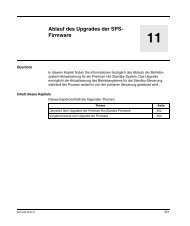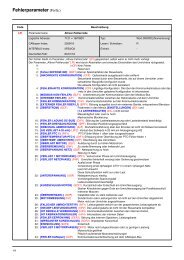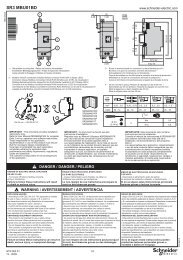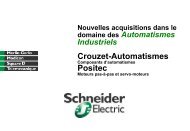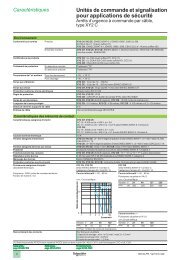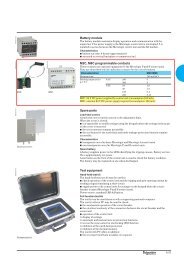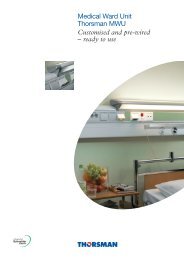Data Center Technology - Schneider Electric
Data Center Technology - Schneider Electric
Data Center Technology - Schneider Electric
You also want an ePaper? Increase the reach of your titles
YUMPU automatically turns print PDFs into web optimized ePapers that Google loves.
<strong>Data</strong> <strong>Center</strong> <strong>Technology</strong>:<br />
Physical Infrastructure<br />
IT Trends Affecting New Technologies and Energy<br />
Efficiency Imperatives in the <strong>Data</strong> <strong>Center</strong><br />
Hisham Elzahhar<br />
Regional Enterprise & System Manager,<br />
<strong>Schneider</strong> <strong>Electric</strong> IT business EMEA, Dubai
Keystrokes Kilowatts<br />
Heat OUT<br />
<strong>Electric</strong>ity IN<br />
<strong>Schneider</strong> <strong>Electric</strong> - Division - Name – Date<br />
2
US <strong>Electric</strong>al Energy Sources 2006<br />
Other Renew ables<br />
Hydro-<strong>Electric</strong> 2%<br />
7%<br />
Nuclear<br />
19%<br />
Natural Gas<br />
20%<br />
Petroleum<br />
2%<br />
CoalCoal<br />
50%<br />
Coal<br />
Petroleum<br />
Natural Gas<br />
Nuclear<br />
Hydro-<strong>Electric</strong><br />
Other Renewables<br />
Source US EIA<br />
<strong>Schneider</strong> <strong>Electric</strong> - Division - Name – Date<br />
3
Prime <strong>Electric</strong>al Source<br />
<strong>Schneider</strong> <strong>Electric</strong> - Division - Name – Date<br />
4
WHICH infrastructure?<br />
BUILDING<br />
infrastructure<br />
“Building systems”<br />
HVAC<br />
<strong>Electric</strong>al system<br />
Fire suppression<br />
Lighting<br />
Security<br />
BMS<br />
DATA CENTER<br />
infrastructure<br />
Power<br />
Cooling<br />
Racks<br />
Management<br />
Lighting<br />
Fire suppression<br />
Physical security<br />
IT<br />
infrastructure<br />
“IT assets”<br />
Servers, storage<br />
hypervisors, , NMS<br />
NETWORK<br />
infrastructure<br />
Switches, cabling,<br />
routers<br />
<strong>Schneider</strong> <strong>Electric</strong> - Division - Name – Date<br />
5
WHICH infrastructure?<br />
Focus of this<br />
discussion<br />
BUILDING<br />
infrastructure<br />
“Building systems”<br />
HVAC<br />
<strong>Electric</strong>al system<br />
Fire suppression<br />
Lighting<br />
Security<br />
BMS<br />
DATA CENTER<br />
infrastructure<br />
Power<br />
Cooling<br />
Racks<br />
Management<br />
Lighting<br />
Fire suppression<br />
Physical security<br />
IT<br />
infrastructure<br />
“IT assets”<br />
Servers, storage<br />
hypervisors, , NMS<br />
NETWORK<br />
infrastructure<br />
Switches, cabling,<br />
routers<br />
<strong>Schneider</strong> <strong>Electric</strong> - Division - Name – Date<br />
6
<strong>Data</strong> center planning and operation<br />
is under increasing pressures<br />
Increasing availability<br />
Rapid changes in<br />
expectations<br />
IT technology<br />
Uncertain<br />
long-term plans for<br />
Energy and service<br />
capacity or density<br />
cost control pressure<br />
High density<br />
blade server<br />
power/heat<br />
Dynamic power<br />
variation<br />
Regulatory<br />
requirements<br />
Server<br />
consolidation<br />
In response, will need to change the way the<br />
world designs, installs, operates, manages, and<br />
maintains data centers<br />
<strong>Schneider</strong> <strong>Electric</strong> - Division - Name – Date<br />
7
The increasing power density<br />
of data centers<br />
Management challenge:<br />
HIGH DENSITY<br />
Power density of IT devices<br />
is leveling off…<br />
… but power density of data centers<br />
data centers<br />
continues to increase due to “packing” of<br />
high-density devices into smaller floor<br />
footprint<br />
2000<br />
2009<br />
KW per rack continues to increase, raising the need<br />
for management to keep things under control<br />
<strong>Schneider</strong> <strong>Electric</strong> - Division - Name – Date<br />
8
High density is stressing<br />
Management challenge:<br />
HIGH DENSITY<br />
power and cooling systems<br />
IT is getting boxed-in by limitations of<br />
power and cooling infrastructure<br />
● High density increases the risk of unpredictable cooling<br />
● Capacity is “tight” in some places, unused and unusable<br />
(“stranded”) in others<br />
● High density requires informed and efficient allocation of<br />
your expensive power/cooling resources<br />
● High density increases the need to know where new devices<br />
can be “squeezed in” to available capacities<br />
<strong>Schneider</strong> <strong>Electric</strong> - Division - Name – Date<br />
9
The Newest Challenge: EFFICIENCY<br />
Efficiency goal:<br />
Provide power and cooling in the amount needed, when needed, and<br />
where needed – but no more than what is required for redundancy<br />
and safety margins<br />
But we can’t manage what we can’t measure<br />
<strong>Schneider</strong> <strong>Electric</strong> - Division - Name – Date<br />
10
<strong>Data</strong>center Efficiency - DCiE<br />
<strong>Data</strong> center<br />
Power to<br />
data center<br />
Power path<br />
to IT<br />
POWER<br />
system<br />
Power<br />
to IT<br />
IT<br />
equipment<br />
Power to<br />
Secondary<br />
Support<br />
COOLING<br />
system<br />
Physical<br />
infrastructure*<br />
*To simplify the analysis, subsystems<br />
consuming a small amount of power<br />
are not included in this discussion:<br />
Cabling Physical security<br />
Switches Generator<br />
Lights Switchgear<br />
White<br />
paper<br />
113<br />
=<br />
<strong>Data</strong> <strong>Center</strong> infrastructure Efficiency<br />
Power<br />
to IT<br />
Power to<br />
data center<br />
( )%<br />
<strong>Schneider</strong> <strong>Electric</strong> - Division - Name – Date<br />
11
<strong>Data</strong>center Efficiency<br />
<strong>Data</strong> <strong>Center</strong><br />
Physical Infrastructure<br />
IT<br />
COOLING<br />
COOLING<br />
system system<br />
POWER POWER<br />
system system<br />
<strong>Schneider</strong> <strong>Electric</strong> - Division - Name – Date<br />
12
Power Chain Losses<br />
4,930 barrels<br />
47 tons SO2<br />
16 tons N2O<br />
6,539 tons CO2<br />
Per mW/yr<br />
1mW<br />
DCiE @ 47%<br />
45 racks @ 10kW<br />
<strong>Schneider</strong> <strong>Electric</strong> - Division - Name – Date<br />
13
Inefficiencies Create Consumption<br />
● Computing inefficiencies > More servers<br />
● Server inefficiencies > More power and cooling<br />
● Power and cooling inefficiencies > More power consumption<br />
Inefficiencies drive both power consumption<br />
and material consumption<br />
<strong>Schneider</strong> <strong>Electric</strong> - Division - Name – Date<br />
14
Primary drivers of inefficiency<br />
● Oversizing of power and cooling equipment<br />
● Pushing cooling systems to cool densities higher than they were<br />
designed for<br />
● Ineffective room layout<br />
● Ineffective airflow patterns<br />
● Redundancy (for availability)<br />
● Inefficient power and cooling equipment<br />
● Inefficient operating settings of cooling equipment<br />
● Clogged air or water filters<br />
● Disabled or malfunctioning cooling economizer modes<br />
● Raised floor clogged with wires<br />
<strong>Schneider</strong> <strong>Electric</strong> - Division - Name – Date<br />
15
Efficiency: key reference points<br />
● More than 50% of the power going into a typical data center<br />
goes to the power and cooling systems – NOT to the IT loads<br />
● The typical 1MW (IT load) data center is continuously wasting<br />
about 400kW or 2,000 tons of coal per year due to poor design<br />
(DCiE = 50%, instead of best-practice 70%)<br />
● Every kW saved in a data center saves about $1,000 per year<br />
● Every kW saved in a data center reduces carbon dioxide<br />
emissions by 5 tons per year<br />
● Every kW saved in a data center has a carbon reduction<br />
equivalent to eliminating about 1 car from the road.<br />
● A 1% improvement in data center infrastructure efficiency (DCiE)<br />
corresponds to approximately 2% reduction in electrical bills<br />
References: APC White Paper 66<br />
<strong>Schneider</strong> <strong>Electric</strong> - Division - Name – Date<br />
16
Power tools for The Efficient Enterprise <br />
<strong>Schneider</strong> <strong>Electric</strong> - Division - Name – Date<br />
17
Power tools – The “Four Cs”<br />
1<br />
2<br />
omponents<br />
MODULAR and SCALABLE, with best-in-class EFFICIENCY<br />
lose-coupled cooling <br />
Placement of cooling units near the heat source<br />
3<br />
ontainment<br />
Thermal containment of airflow in high-density zones<br />
4<br />
apacity management<br />
Instrumented intelligence to optimize use of power and<br />
cooling capacity<br />
<strong>Schneider</strong> <strong>Electric</strong> - Division - Name – Date<br />
18
1<br />
omponents with the “right stuff”<br />
Best-in-class component EFFICIENCY<br />
Efficient<br />
Agile<br />
MODULAR SCALABLE component design<br />
Scalable<br />
External modularity<br />
Internal modularity<br />
<strong>Schneider</strong> <strong>Electric</strong> - Division - Name – Date<br />
19
Problem: Underloading<br />
Low loading = low efficiency<br />
In a traditional data center, over half the power consumption<br />
of the power/cooling infrastructure is fixed and does not go down<br />
when IT load goes down<br />
Efficiency degrades as IT load declines<br />
Underloading is a primary contributor to inefficiency<br />
<strong>Data</strong> center<br />
Efficiency<br />
E ffic ie n c y<br />
100%<br />
90%<br />
80%<br />
70%<br />
60%<br />
50%<br />
40%<br />
30%<br />
20%<br />
10%<br />
0%<br />
Efficiency degrades at low loads<br />
Typical load range<br />
0% 10% 20% 30% 40% 50% 60% 70% 80% 90% 100%<br />
% IT Load<br />
IT load<br />
<strong>Schneider</strong> <strong>Electric</strong> - Division - Name – Date<br />
20
Solution: Right-sizing<br />
Efficiency gain through modular scalable<br />
buildout – avoids oversizing / underloading<br />
<strong>Data</strong> center<br />
Efficiency<br />
Efficiency<br />
100%<br />
90%<br />
80%<br />
70%<br />
60%<br />
50%<br />
40%<br />
30%<br />
20%<br />
10%<br />
0%<br />
Power and cooling<br />
installation method<br />
0% 10% 20% 30% 40% 50% 60% 70% 80% 90% 100%<br />
% IT load Load<br />
<strong>Schneider</strong> <strong>Electric</strong> - Division - Name – Date<br />
21
Modular scalable design<br />
Reduce power consumption up to 30% by “right<br />
right-sizing<br />
sizing”<br />
power and cooling infrastructure<br />
●<br />
●<br />
Avoid underloading run more efficiently<br />
Pay only for what you need, when you need it<br />
P = Power C = Cooling R = Racks<br />
<strong>Schneider</strong> <strong>Electric</strong> - Division - Name – Date<br />
22
500kW of scalable, high-efficiency<br />
power protection<br />
100kW 125kW 150kW 175kW 200kW 225kW 250kW 275kW 300kW 325kW 350kW 375kW 400kW 425kW 450kW 500kW 475kW<br />
<strong>Schneider</strong> <strong>Electric</strong> - Division - Name – Date<br />
23
lose-coupled cooling<br />
Reduce power consumption up to 20% with InRow ®<br />
architecture<br />
●<br />
●<br />
●<br />
●<br />
Closely couples cooling with heat load, preventing exhaust air<br />
recirculation<br />
Less fan power than traditional raised-floor system<br />
Varying equipment temperatures are constantly held to set point<br />
conditions<br />
Lowers operating cost by monitoring inlet temperatures to modulate<br />
cooling capacity based on the cooling demand<br />
Fan speed adjusts to follow changing IT heat<br />
load<br />
<strong>Schneider</strong> <strong>Electric</strong> - Division - Name – Date<br />
24
Close-coupled cooling <br />
InRow ® air<br />
conditioner<br />
Heat captured and<br />
rejected to chilled water<br />
Cold air is supplied<br />
to the cold aisle<br />
Hot-aisle air enters from<br />
rear, preventing mixing<br />
Hot aisle<br />
Cold aisle<br />
Can operate on hard<br />
floor or raised floor<br />
<strong>Schneider</strong> <strong>Electric</strong> - Division - Name – Date<br />
25
Efficiency comparison<br />
100%<br />
90%<br />
Cooling Efficiency<br />
Cooling<br />
efficiency<br />
80%<br />
70%<br />
60%<br />
50%<br />
40%<br />
0% 10% 20% 30% 40% 50% 60% 70% 80% 90% 100%<br />
IT load<br />
% IT Load<br />
Cooling efficiency = useful cooling power / (power consumed + useful cooling power)<br />
<strong>Schneider</strong> <strong>Electric</strong> - Division - Name – Date<br />
26
ontainment<br />
Eliminate expensive temperature cross-contamination<br />
contamination<br />
with thermal containment options<br />
●<br />
●<br />
●<br />
●<br />
Simplifies analysis and understanding<br />
of the thermal environment<br />
Increases predictability of the cooling<br />
system<br />
Increases cooling EFFICIENCY and<br />
cooling CAPACITY by returning warmest possible air to cooling<br />
units<br />
Ensures proper air distribution by<br />
separating supply and return air paths<br />
Hot Aisle Containment (HAC)<br />
Rack Air Containment (RAC)<br />
<strong>Schneider</strong> <strong>Electric</strong> - Division - Name – Date<br />
27
Rack Air Containment<br />
Rear<br />
Rear<br />
Containment<br />
●<br />
Rear containment prevents<br />
hot exhaust air from escaping<br />
InRow<br />
cooling<br />
unit<br />
InRow<br />
cooling<br />
unit<br />
●<br />
●<br />
●<br />
All exhaust air is returned to<br />
InRow ® cooling unit<br />
Optional front containment<br />
directs cool air to front of<br />
servers<br />
Allows up to 60 kW per rack<br />
(30 kW with N+1 redundancy)<br />
NetShelter SX<br />
rack<br />
Front<br />
Containment<br />
Front<br />
Top Down View<br />
<strong>Schneider</strong> <strong>Electric</strong> - Division - Name – Date<br />
28
Hot aisle containment vs traditional<br />
room cooling<br />
●Inherently higher power<br />
density capability than room<br />
designs<br />
●Fan power is reduced by 50%<br />
●Needless dehumidification /<br />
re-humidification is eliminated<br />
●Need for high-bay areas and<br />
raised floors is reduced or<br />
eliminated (particularly for small<br />
installations)<br />
●Cooling capacity can “follow”<br />
IT loads that move due to<br />
virtualization and server power<br />
management<br />
C o o l i n g E f f i c i e n c y<br />
100%<br />
90%<br />
80%<br />
70%<br />
60%<br />
50%<br />
40%<br />
0% 10% 20% 30% 40% 50% 60% 70% 80% 90% 100%<br />
% IT Load<br />
Cooling efficiency = useful cooling power /<br />
(power consumed + useful cooling power)<br />
<strong>Schneider</strong> <strong>Electric</strong> - Division - Name – Date<br />
29
Hot Aisle Containment areas<br />
can be added as needed<br />
<strong>Schneider</strong> <strong>Electric</strong> - Division - Name – Date<br />
30
apacity Management<br />
Increase IT staff efficiency with predictable<br />
Capacity Management<br />
●<br />
●<br />
●<br />
Identify over- and under-utilized areas of your data<br />
center<br />
Minimize waste and human error<br />
via predictable software monitoring, sensing, and<br />
environmental control<br />
Quickly adapt to change with<br />
real-time data on what to power<br />
and where to cool<br />
<strong>Schneider</strong> <strong>Electric</strong> - Division - Name – Date<br />
31
Capacity Manager <br />
Physical equipment<br />
provisioning<br />
Quickly locate the optimum spot<br />
for that next server based on<br />
space, cooling, and power needs<br />
Rack elevations<br />
Easy-to-use front view for<br />
accurate and detailed<br />
representation of equipment<br />
layout<br />
Airflow analysis<br />
Locate new devices without<br />
overheating new or existing<br />
equipment by simulating<br />
changes in; supply<br />
temperature, airflow and<br />
number of cooling units<br />
Available capacity<br />
Understand available capacity by<br />
calculating actual space, power<br />
and cooling consumption against<br />
data center architecture<br />
constraints<br />
Capacity grouping<br />
Specify architecture<br />
capabilities to; match IT<br />
equipment with availability<br />
needs ad avoid stranded<br />
space, power and cooling<br />
capacity<br />
Design analysis<br />
Model the effects of and<br />
compare alternative layouts<br />
through detailed design<br />
analysis<br />
<strong>Schneider</strong> <strong>Electric</strong> - Division - Name – Date<br />
32
Capacity and energy<br />
management<br />
●Poor utilization of capacity is a<br />
primary cause of inefficiency<br />
●Software can identify available<br />
capacity (even by rack) and<br />
help prevent creation of<br />
stranded capacity<br />
●Side effect is you can fit more<br />
IT equipment in the power and<br />
cooling “envelope” of the data<br />
center<br />
●Energy management can<br />
identify efficiency improvement<br />
opportunities<br />
Infrastructure Central Software<br />
With Capacity Manager<br />
<strong>Schneider</strong> <strong>Electric</strong> - Division - Name – Date<br />
33
Power consumptions compared to the<br />
IT load<br />
IT Load<br />
Aux Devices<br />
Lights<br />
Humidifier<br />
Chiller<br />
Pumps<br />
Heat Rejection<br />
CRAC<br />
Distribution Wiring<br />
Switchgear<br />
Generator<br />
Improving efficiency<br />
means working to<br />
reduce power<br />
consumption (increase<br />
efficiency) for each of<br />
these device categories<br />
PDU<br />
UPS<br />
Reference: APC White Paper 114<br />
0% 20% 40% 60% 80% 100% 120%<br />
Power<br />
Power<br />
consumption<br />
Consumption<br />
as<br />
as<br />
% of<br />
%<br />
the<br />
of IT<br />
IT<br />
Load<br />
load<br />
0.0% 20.0% 40.0% 60.0% 80.0% 100.0% 120.0%<br />
<strong>Data</strong> for a typical tier 4 data center operating at 30% of rated load<br />
<strong>Schneider</strong> <strong>Electric</strong> - Division - Name – Date<br />
34
Drivers of infrastructure efficiency gains<br />
(Baseline: Average of existing installed base)<br />
IMPROVEMENT Device Gain DCiE Gain<br />
$$ saved over 15<br />
years in a 1MW data<br />
center**<br />
Move from room cooling to<br />
dynamic row/rack cooling<br />
70% 8% $5,900,000<br />
Cooling economizers 38% 4% $2,500,000<br />
Right-sizing through modular<br />
power and cooling equipment<br />
4% 4% $2,400,000<br />
Higher UPS efficiency 8% 4% $1,900,000<br />
415/240 V transformerless<br />
power distribution (NAM)*<br />
Dynamic control of cooling<br />
plant (VFD fans, pumps,<br />
chillers)<br />
4% 2.5% $1,500,000<br />
25% 2.5% $1,200,000<br />
TOTAL to get industry<br />
from 47% to 72% DCiE 25%<br />
25% $14,700,000<br />
*No benefit outside of NAM; Transformer based PDUs typically in NAM only<br />
**$$ values based on $.15 per kwh electric cost, starting DCiE of 47%, ave density 8KW/rack<br />
<strong>Schneider</strong> <strong>Electric</strong> - Division - Name – Date<br />
35
Power Chain Losses – Could Be<br />
4,930 barrels<br />
6,539 tons CO2<br />
47 tons SO2<br />
16 tons N2O<br />
Per mW/yr<br />
1,971 barrels<br />
2,615 tons CO2<br />
19 tons SO2<br />
6 tons N2O<br />
1mW<br />
400kW<br />
DCiE @ 70%<br />
<strong>Schneider</strong> <strong>Electric</strong> - Division - Name – Date<br />
36
Visit us<br />
Hall 4, booth 4405<br />
(next to the BP Carbon Theater)<br />
Tour the booth and be entered into our daily lottery<br />
The lucky winner to receive a brand new<br />
Amazon Kindle e-reading device right away!<br />
<strong>Schneider</strong> <strong>Electric</strong> - Division - Name – Date<br />
37
Questions?<br />
<strong>Schneider</strong> <strong>Electric</strong> - Division - Name – Date<br />
38



